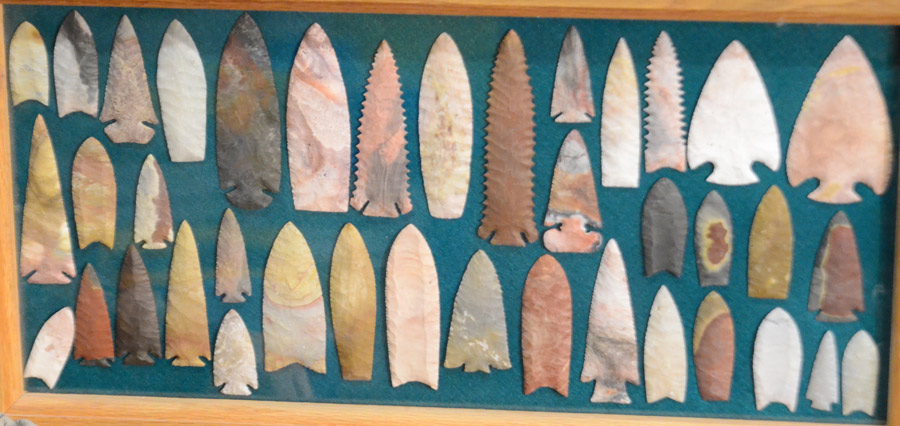
A display case in Mesaros workshop shows the various shapes of arrowheads he had created, replicating those made by the various Native Americans.
Jeff Mesaros, Syracuse, has taken up a hobby that is a lost art, even for those whose ancestors were the original creators.

Jeff Mesaros, Syracuse, has learned a skill that is a rare art form and one not many have undertaken. He is a flintknapper. Mesaros takes special stone and flakes it into arrowheads. He is shown using a “copper bopper” he fashioned to flake the stone down to the size he needs before notching the edges into the necessary shape.
It started when he was a young child and finding his first arrowhead. His curiosity kicked in and questions arose on how those arrowheads were made. He spent time researching the art of flintknapping, defined as the making of flaked or chipped stone tools used to make spear and dart points, arrow heads, knives, scrapers, blades and many others. The work is tedious, requires a lot of practice, knowledge and skill.
He spoke with others who worked in the past in the art, who are not many and who live outside of Indiana, began attending gatherings of flintknappers, studied geology books on rocks and lithic resources. The passion took off from there with lots of practice (including cuts) and lots of rocks.
Mesaros has been a flintknapper for close to 15 years, making thousands of points he sells or displays, teaches others and continues to hone his own skills.
“It took a lot of failures,” Mesaros said noting it took him almost two years before his first arrowhead came out the right way. “I have buckets full of failures, have had lots of cut fingers. But I was determined to keep at it and it paid off. There’s always the next level and I’m trying to achieve that, to keep getting better and better.”
He gathers his own stone, making several “rock trips” a year. “I literally get in the area of the flint source, go up and down creeks and hills, gathering rocks and bring it back,” Mesaros said. These locations have been located through his research where to find the material. “I have rock from Texas to Wisconsin,” he noted. “Anything that will take a flake and make an edge they (the Indians) used. I try to replicate the same material and point types they did.”
To do this he has studied artifact books and magazines, gone to artifact shows, visited museums and studied pieces. “Mine look a little different than theirs, some more refined, some cruder, depending on the type of blade or point … I do flaking like they did.”
The rocks are often procured before going through the stages to get it to a workable piece. The waste or cortex of the rock is removed and the stone heat treated in a kiln, where the temperature can be controlled. “I tried to do it under fire before, but it is hard to control
the temperature.”
Using tools he made, the work of flaking the stone to the proper size and notching begins. Mesaros noted a small point can usually be completed in 1-1 ½ hours, while the larger points or blades could take from three hours to several days. A copper bopper – a led filled copper cap on a handle, a copper nail for a pressure plater and a steel nail shaped like a screwdriver to do the nothing. He has used an antler billet and deer tine, like Native Americans, to recreate the artifacts.
Many of his creations are used by local hunters who hunt with traditional archery, used for skinning animals, displays and some of the flints are used to start campfires for those recreating historic campsites or Scouts.
Mesaros, a native of Muncie, is not unfamiliar with the area. His mother is Janet Hartley and he came to the lake as a youngster and moved to the area permanently 15-16 years ago. “I fished and skied here as a child,” he said, adding “I like this area, the lake area and the people.”





